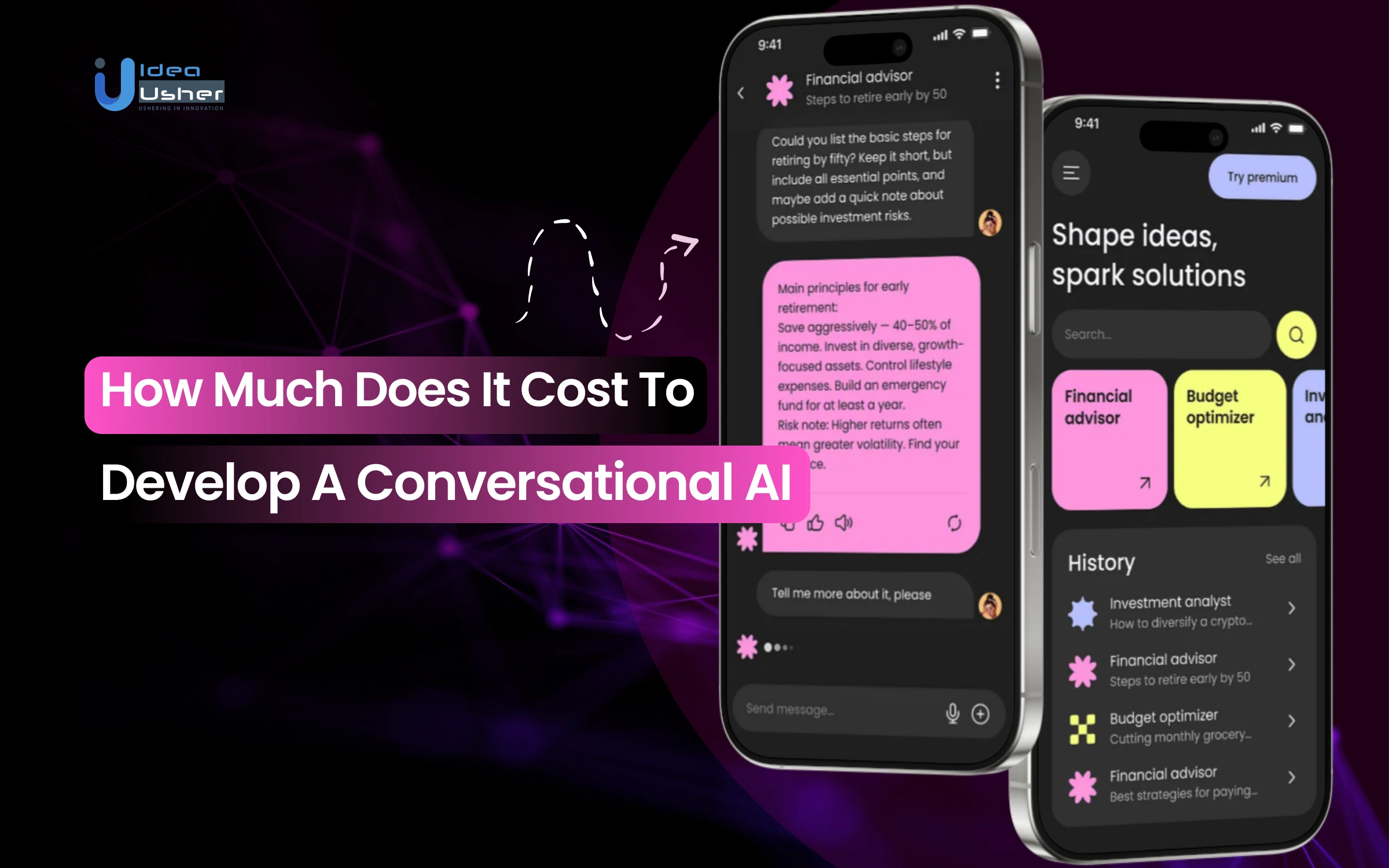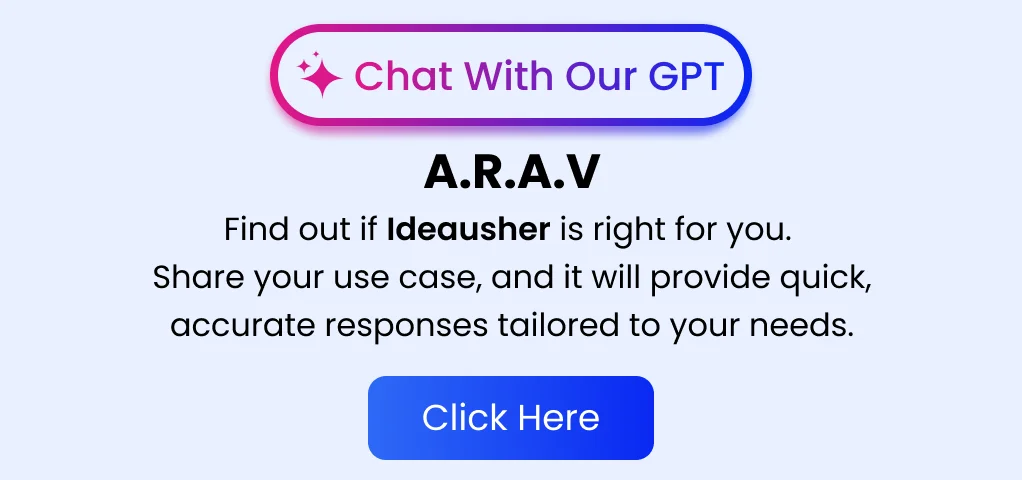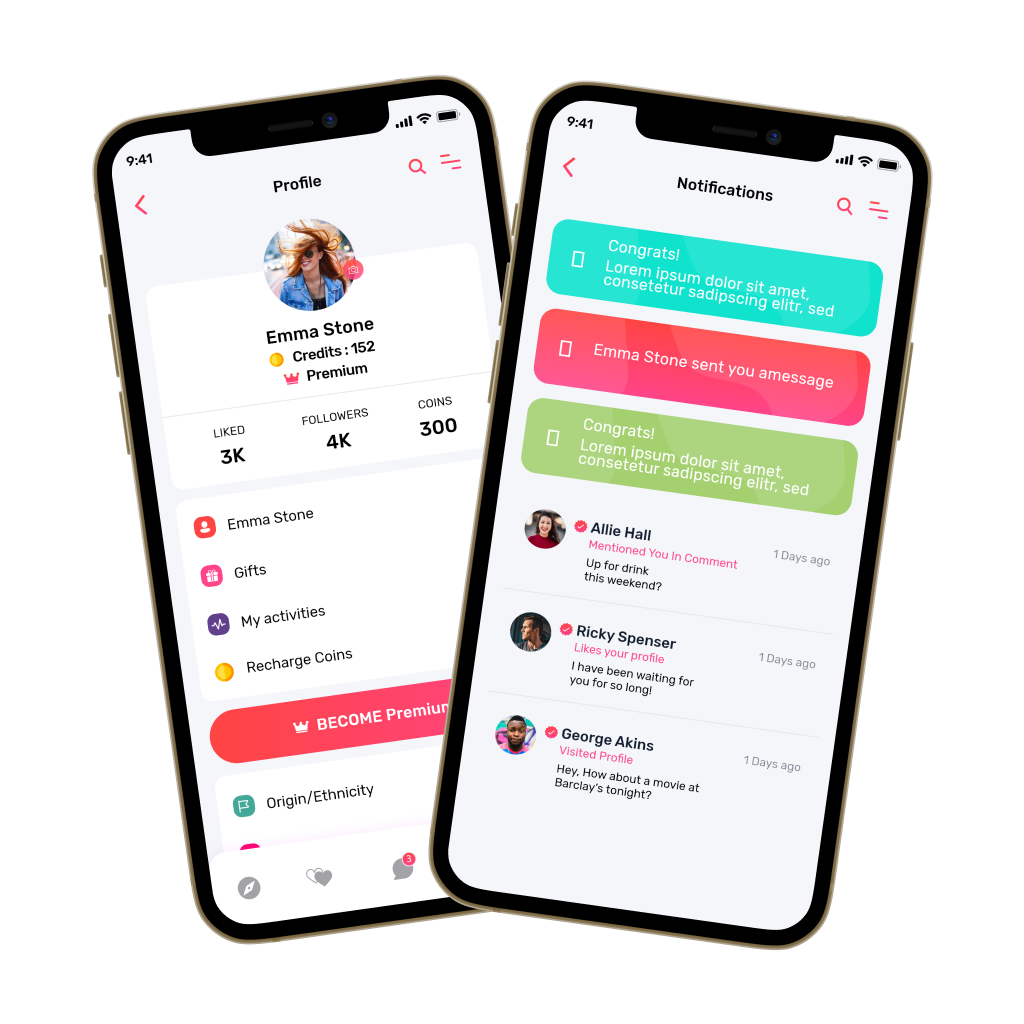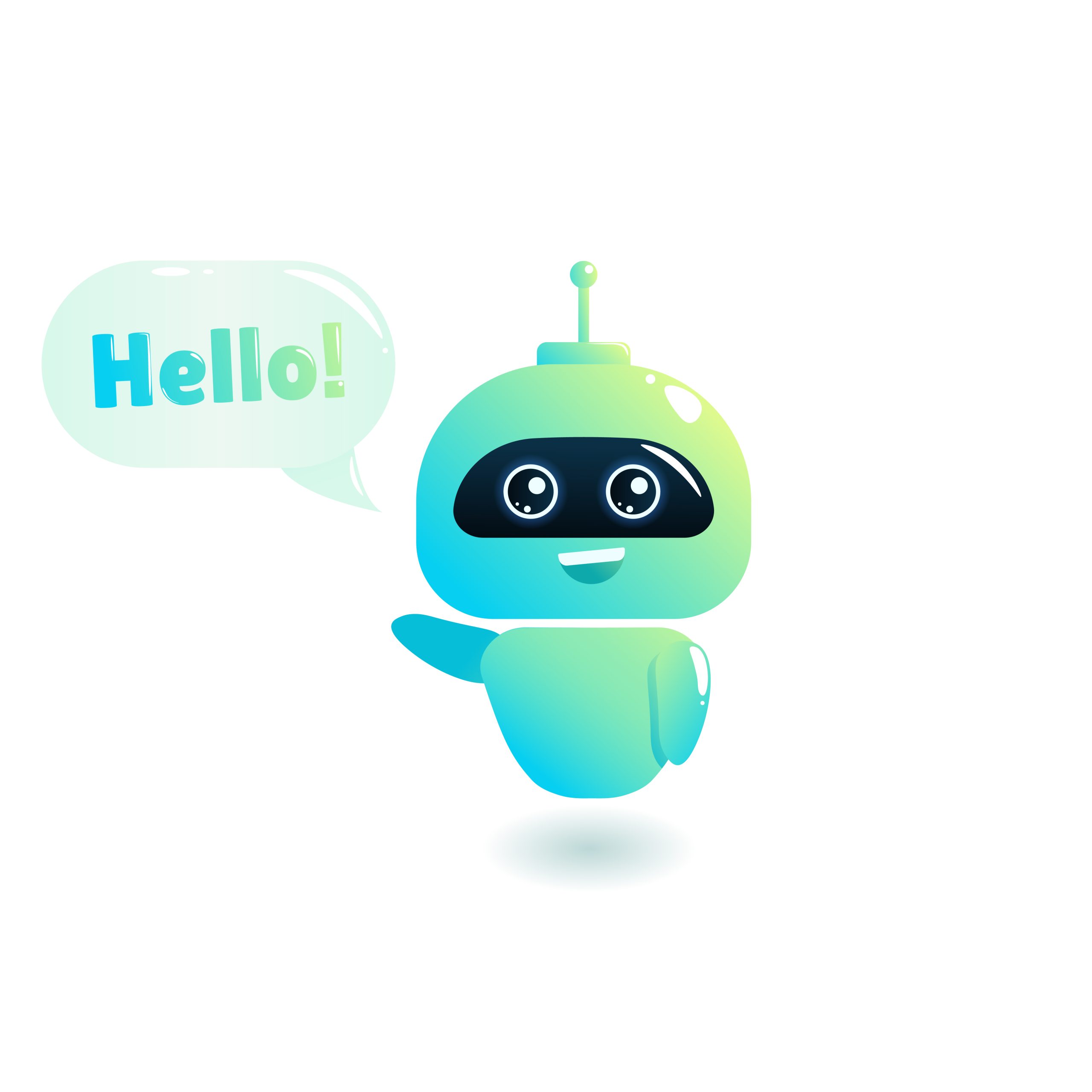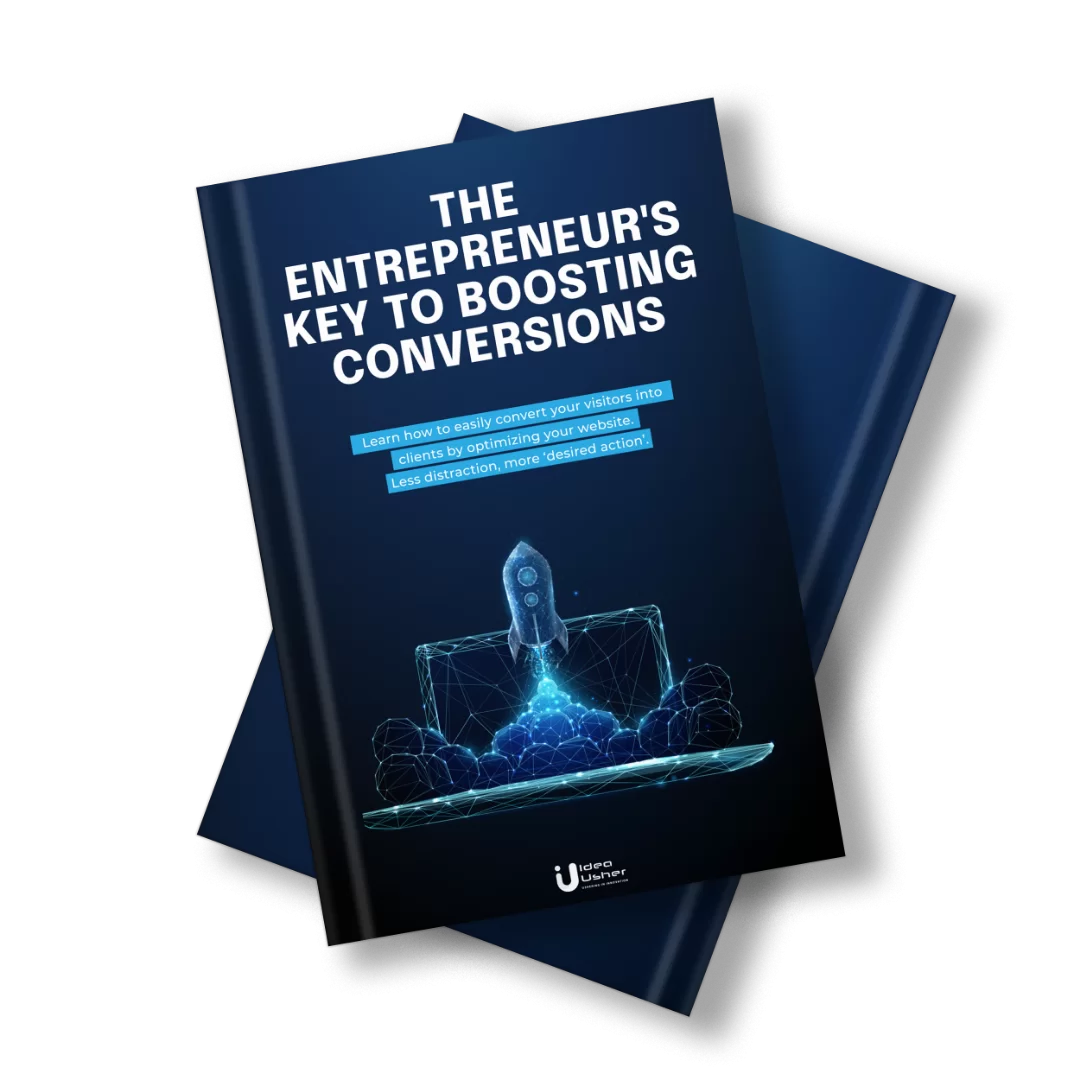Every interaction today is slowly moving toward automation, and businesses cannot keep relying on chatbots that sound lifeless. People now want digital conversations that actually understand their tone and meaning. They wish the system could remember what they said before and respond more naturally. Conversational AI is making that possible through intent recognition and adaptive learning. It can manage both text and voice without losing context in between.
These systems may also learn from each exchange to better serve users. They can instantly offer support or guide someone through a process with ease. This technology is already changing how people connect with brands every day.
Over the years, we’ve worked with several enterprises and customer-centric platforms and developed numerous Conversational AI solutions, powered by NLP and ML-based dialogue management. With this expertise, we’re putting together this blog to discuss what it might cost to develop a Conversational AI and which technical choices can truly shape its success.
Key Market Takeaways for Conversational AI
According to FortuneBusinessInsights, the global conversational AI market is growing at an impressive pace, reaching an estimated USD 12.24 billion in 2024 and expected to climb to USD 61.69 billion by 2032. This steady rise, driven by a CAGR of 22.6%, reflects how quickly businesses are embracing AI to improve communication and service delivery.
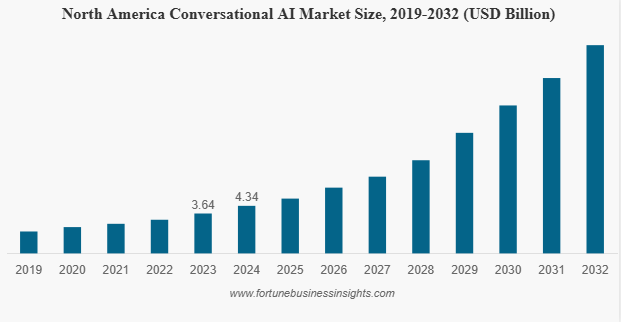
Source: FortuneBusinessInsights
North America continues to lead with over a third of the market share, supported by strong investments and a mature digital ecosystem that encourages rapid adoption of emerging technologies.
Conversational AI tools like chatbots and virtual assistants are transforming how people and organizations interact. Progress in natural language processing, automation, and personalized engagement has made these tools indispensable across industries.
Platforms such as OpenAI’s ChatGPT and Google’s Dialogflow are powering intelligent customer support systems and productivity tools that can understand context, manage complex inquiries, and reduce costs while maintaining a human touch.
Strategic collaborations are further accelerating the sector’s momentum. A key example is the partnership between Microsoft and Nuance Communications, which combines conversational AI with healthcare cloud services to simplify clinical documentation and enhance patient experiences.
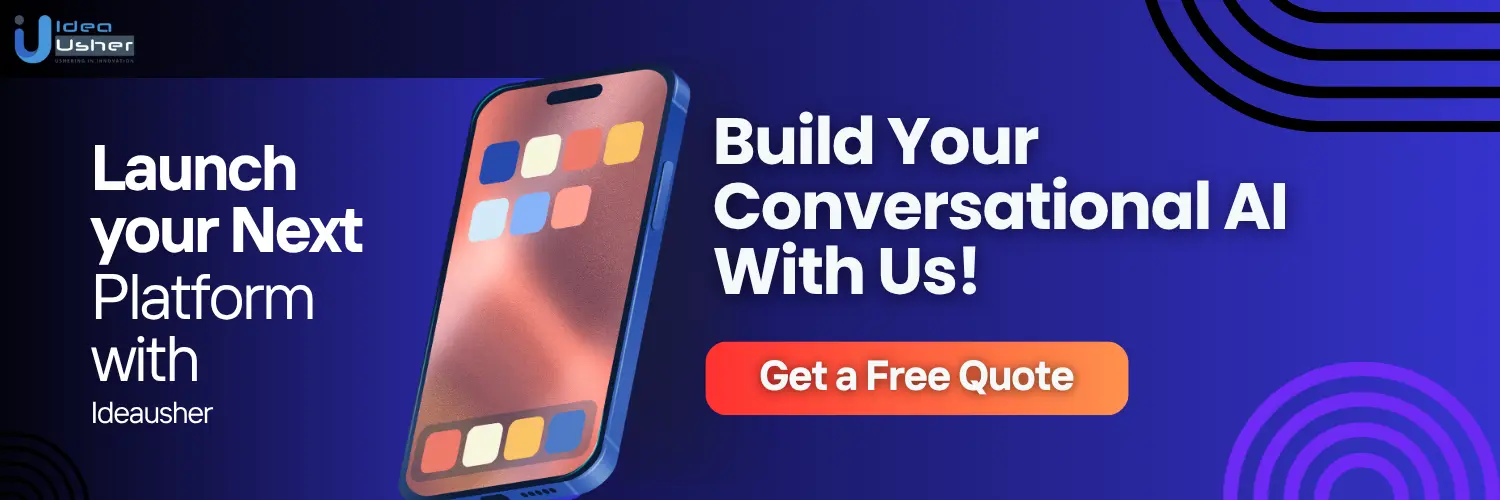
What Is a Conversational AI?
Conversational AI is an advanced form of artificial intelligence that enables machines to understand, interpret, and respond to human language in a natural and meaningful way. Unlike traditional chatbots that rely on rigid, rule-based scripts, Conversational AI uses NLP and ML to recognize intent, interpret context, and carry out fluid, multi-turn conversations.
Whether you type or speak, Conversational AI can process your input, understand what you mean, and respond in a way that feels intuitive. It learns from every interaction, allowing it to handle complex tasks, automate workflows, and turn static exchanges into natural, human-like dialogues that actually get things done.
What Makes Conversational AI Different?
The difference lies beneath the surface. Traditional chatbots respond to exact keywords; Conversational AI understands meaning. It’s powered by a combination of technologies that work together to interpret and respond intelligently:
- Natural Language Processing: Breaks down the grammar, structure, and meaning of a user’s message so the system can interpret it accurately.
- Machine Learning: Continuously improves the system’s understanding and accuracy by learning from millions of past conversations.
- Large Language Models: Advanced models like GPT, Gemini, and Claude generate contextually relevant, human-like responses in real time.
Together, these technologies allow Conversational AI to recognize that “Where’s my order?” and “I haven’t received my package yet” express the same intent, even though the phrasing is entirely different.
Different Types of Conversational AI
Not every conversational system is equally intelligent. They fall along a spectrum of capability, ranging from rule-based bots to advanced, generative AI assistants.
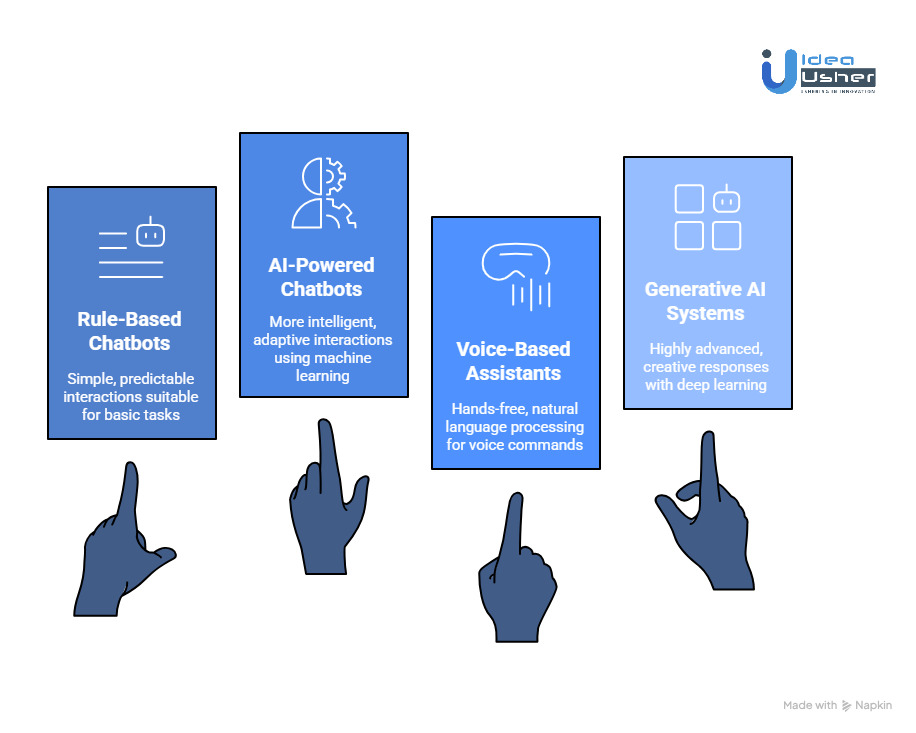
1. Rule-Based Chatbots
These are the earliest chatbots, built on fixed decision trees and keyword triggers. If a user types the exact phrase the bot is programmed to recognize, it provides the corresponding response.
Best for: Answering simple, repetitive questions such as “What are your business hours?” or “How do I reset my password?” They are inexpensive and reliable for basic tasks but easily fail when faced with unexpected input.
2. AI-Powered Chatbots
These bots introduce real intelligence. By using NLP and ML, they can understand intent even when the phrasing changes. They improve through continuous learning, making interactions smoother and more accurate over time.
Best for: Customer support, lead qualification, order tracking, and appointment scheduling, situations that require some flexibility and contextual understanding.
3. Voice-Based Assistants
Voice-based systems take conversational AI a step further by adding sound. They use Automatic Speech Recognition to turn spoken words into text, process that text through NLP, and respond using Text-to-Speech technology.
Best for: Hands-free environments such as call centers, in-car assistants, or smart home devices, where users interact through spoken language rather than typing.
4. Generative AI Systems
This represents the cutting edge of conversational technology. Built on powerful Large Language Models, these systems don’t rely on a fixed set of answers. Instead, they generate responses dynamically based on the context and information available. They can summarize data, compose content, and explain complex ideas clearly and naturally.
Best for: Creating personalized and engaging user experiences, enhancing internal knowledge bases, supporting creative work, and assisting with complex problem-solving or analytical tasks.
Why Businesses Are Investing in Conversational AI?
Businesses are investing in conversational AI because it can truly transform how they connect with customers. It helps them respond faster, work smarter, and scale without losing the human touch. You might even say it lets a brand sound more alive while saving time and money every single day.
1. Unmatched Cost Efficiency and Operational Savings
Scaling traditional customer service typically means adding more agents, training programs, and overhead costs. Conversational AI changes this equation by automating high-volume, repetitive tasks that do not require human judgment.
Real-World Example: KLM Royal Dutch Airlines
KLM uses a sophisticated AI-powered assistant to manage more than 17,000 customer conversations every week. The system automates complex actions such as rebooking flights, sending boarding passes, and handling multilingual baggage inquiries.
2. Elevating Customer Experience and Driving Retention
Customers expect instant answers and frictionless service. Conversational AI delivers both by responding in real time, 24/7, across any channel. When users feel heard and helped instantly, loyalty naturally follows.
Real-World Example: Domino’s Pizza
Domino’s “Dom” chatbot lets customers place orders through a natural chat experience on Facebook Messenger, Twitter, Alexa, or the Domino’s app. It makes ordering as easy as texting a friend.
3. Turning Conversations into Data-Driven Insights
Every customer interaction holds valuable business intelligence. Conversational AI captures and organizes this data at scale, revealing patterns that traditional analytics might miss.
Real-World Example: Starbucks
The “My Starbucks Barista” AI lets customers order and pay through voice or text. Behind the scenes, the system analyzes millions of these interactions to uncover insights about top-selling drinks, common customizations, and regional trends.
4. Infinite Scalability Without Added Headcount
Human teams can only scale so far. When demand spikes, response times drop and customer satisfaction suffers. Conversational AI solves this problem by providing instant scalability that allows thousands or even millions of simultaneous interactions without compromising quality.
Real-World Example: Lego
During the holiday rush, Lego’s AI-powered assistant, “Ralph the Gift Bot,” helps shoppers find the right toy. It asks simple, conversational questions about age and interests, then suggests the perfect match from Lego’s catalog.
The bot can handle massive volumes of customer requests simultaneously, ensuring every visitor receives personalized attention without requiring seasonal staff increases. It is scalability in action: reliable, consistent, and cost-efficient.

How Much Does It Cost to Develop a Conversational AI?
We take a cost-effective, transparent approach to developing Conversational AI solutions for our clients. Our goal is to balance innovation with efficiency so that every dollar spent directly contributes to performance, scalability, and measurable business value.
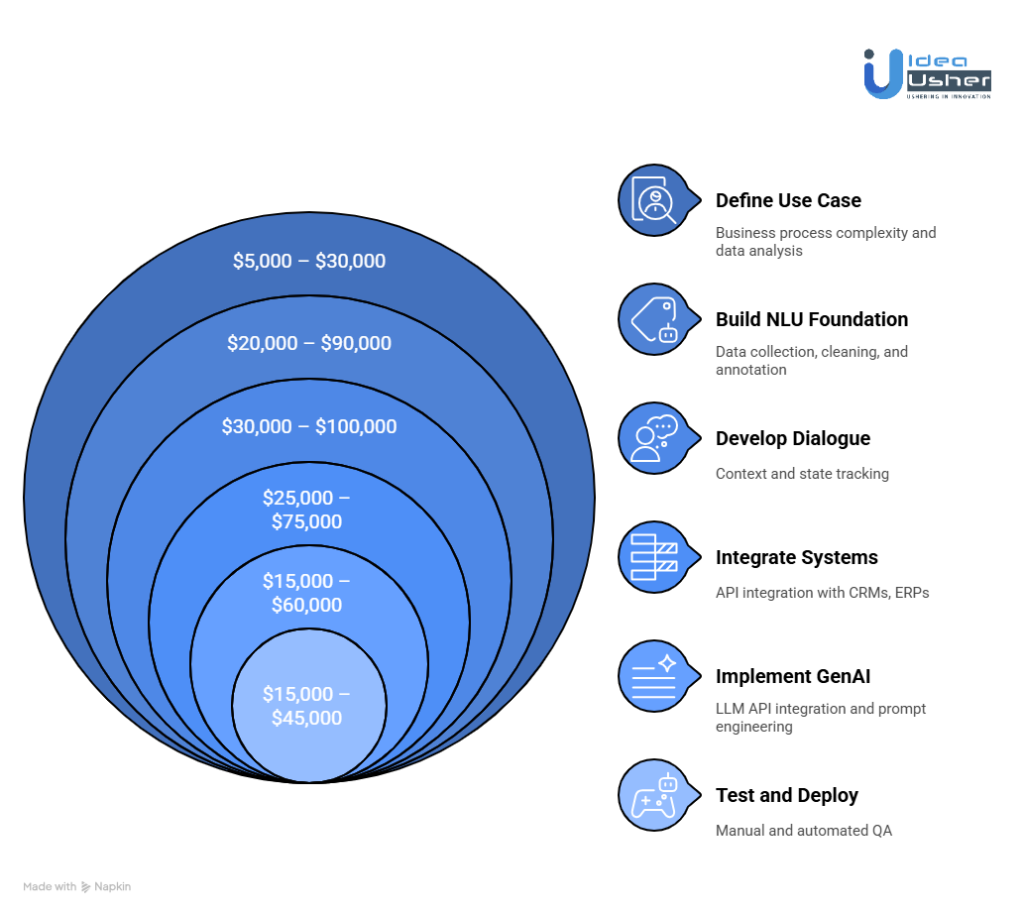
Overall Development Cost Benchmarks
| Complexity Level | Typical Use Case | Development Cost Range (One-Time) | Estimated Timeline |
| Low-to-Medium | Simple FAQ Bot, Rule-Based, Basic Lead Capture | $10,000 – $50,000 | 1–3 Months |
| Medium-to-High | NLP-Driven, Contextual, 1–2 API Integrations (e.g., Order Status) | $50,000 – $150,000 | 3–6 Months |
| Enterprise-Grade | Custom LLM/GenAI, Multi-Channel, Complex Transactions, Multiple Integrations, Security/Compliance | $150,000 – $500,000+ | 6–12+ Months |
Detailed Cost Breakdown by Development Phase
| Phase | Approx. % of Total Cost | Illustrative Range (USD) | Key Cost Drivers |
| Phase 1: Define Use Case and Objectives (Discovery & Planning) | 5% – 15% | $5,000 – $30,000 | – Complexity of business processes and data analysis- Time spent by Strategists, UX Designers, and Architects- Platform selection (PaaS vs. custom LLM) |
| Phase 2: Build the NLU Foundation (Data & Model Training) | 15% – 30% | $20,000 – $90,000 | – Data collection, cleaning, and annotation- Licensing for NLP tools- Number of intents and entities- Multi-turn context design complexity |
| Phase 3: Develop the Dialogue Management System (Core Logic) | 20% – 35% | $30,000 – $100,000 | – Context and state tracking- Handling user interruptions and corrections- Human handoff logic- Channel development (Web, App, WhatsApp, Voice) |
| Phase 4: Integrate External Systems (Fulfillment Layer) | 15% – 25% | $25,000 – $75,000 | – API integration with CRMs, ERPs, or legacy systems- Tool-calling and secure microservices- Compliance and security (HIPAA, GDPR, FINRA) |
| Phase 5: Implement Generative AI Capabilities (LLM Integration) | 10% – 20% | $15,000 – $60,000 | – LLM API integration and prompt engineering- Fine-tuning for tone and domain- Retrieval-Augmented Generation (RAG) setup- Guardrails and moderation systems |
| Phase 6: Test, Deploy, and Continuously Improve (Post-Launch) | 10% – 15% | $15,000 – $45,000 | – Manual and automated QA- Cloud deployment setup- Analytics and monitoring tools- Ongoing operational costs (APIs, hosting, retraining) |
These figures are only broad estimates based on typical project scopes and complexity levels. In most cases, the total development cost for a full Conversational AI solution ranges from $10,000 to $500,000 USD. For a more accurate quote tailored to your goals and systems, feel free to reach out to us for a free consultation.
Factors Affecting the Cost to Develop a Conversational AI
The cost to develop a conversational AI can vary widely, depending on what you want it to do and how complex it needs to be. You might start with a simple text bot or move toward a smarter system that speaks and understands multiple languages.
You should expect the price to grow as you add features, deeper integrations, or tighter security, since each layer takes more time and expertise to build.
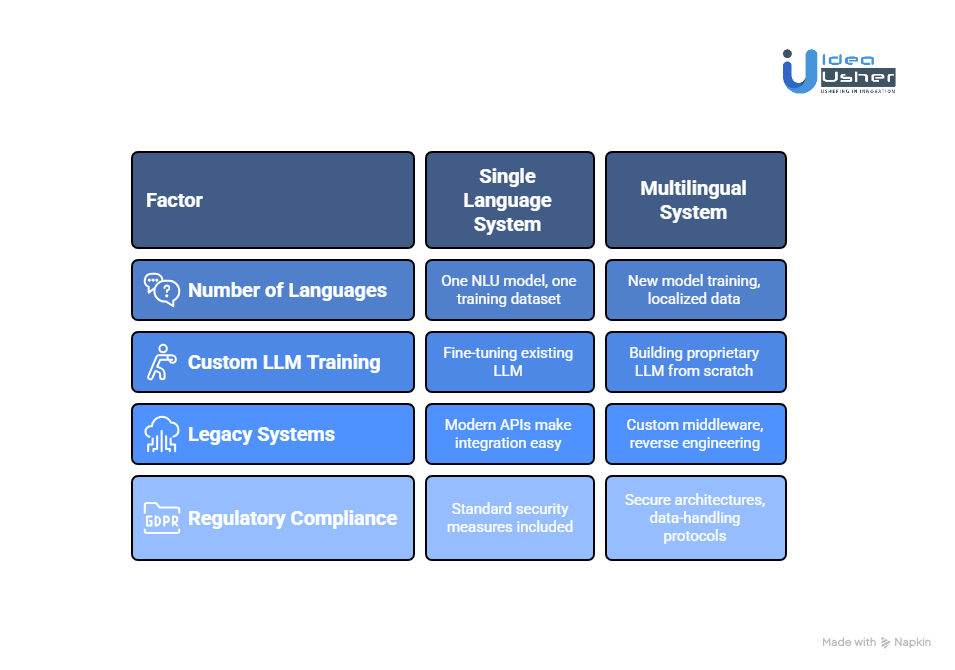
1. Voice vs. Text: Interface Complexity
Text-based chatbots are the most affordable entry point. They rely on Natural Language Understanding and dialogue management to process and respond to user input.
Voice-based assistants, on the other hand, add layers of complexity. They require Speech-to-Text and Text-to-Speech technologies, along with a specialized design for voice-only interaction.
Cost Impact: Upgrading to a conversational voice interface can add $40,000 to $100,000 or more. This includes licensing for premium STT/TTS providers such as Google, Amazon, and Microsoft, as well as additional design and development time.
2. Number of Languages: The Multilingual Multiplier
Single Language Systems require one NLU model and one training dataset.
Multilingual Systems require much more. Each language involves new model training, localized data collection, and annotation by native linguists.
Cost Impact: Expect to add $25,000 to $60,000 per additional language, depending on complexity and the availability of high-quality training data.
3. Custom LLM Training: The Frontier of AI Investment
Fine-tuning an Existing LLM, such as GPT-4 or Claud,e is the most practical approach. It adapts a powerful base model to your company’s data and domain.
Building a Proprietary LLM from scratch is a massive undertaking that requires extensive computing power, infrastructure, and AI research expertise.
Cost Impact:
- Fine-tuning: $10,000 to $50,000
- Building from scratch: $2 million to $10 million or more
For nearly all organizations, fine-tuning or using retrieval-augmented generation (RAG) is the smart, cost-effective choice.
4. Legacy Systems: The Hidden Integration Tax
Modern APIs make integration relatively easy when systems are well-documented and RESTful.
Legacy Systems, however, often lack proper APIs. They demand custom middleware, reverse engineering, and intensive development work.
Cost Impact: Integrating with legacy systems can add $50,000 to $200,000 or more, potentially doubling your integration budget depending on system complexity.
5. Regulatory Compliance: The Cost of Trust and Security
Standard Security measures, such as encryption and access control, are included in all modern AI solutions.
Industry-specific compliance requirements, such as HIPAA or PCI DSS, are more demanding. They require secure architectures, data-handling protocols, and audit-ready documentation.
Cost Impact: Compliance can add $40,000 to $150,000 or more, covering expert consultation, infrastructure enhancements, and certification processes.
How Conversational AI Can Increase Customer Support Productivity by 14%?
Recent research from a Fortune 500 software company found that customer support agents using a generative AI assistant saw a 14% increase in productivity, measured by the number of issues resolved per hour. This boost occurs because AI helps agents eliminate common friction points that slow them down.
Instead of spending time searching for information or drafting responses, agents can focus on solving problems more efficiently. The result is a faster and more effective support process.
1. Instant Knowledge Retrieval
A major portion of an agent’s time is spent searching for information across knowledge bases, internal wikis, and past tickets.
- The Friction: When an agent receives a query about a specific error code, they often spend 3-5 minutes searching through different resources to find the correct solution.
- The AI Solution: The conversational assistant, integrated with all company databases, instantly pulls up the relevant solution, step-by-step troubleshooting guide, and related knowledge base articles as soon as the ticket is opened.
The Productivity Gain: Agents move from searching to solving in seconds, reclaiming minutes on each ticket.
2. Intelligent Response Drafting
Crafting a clear, accurate, and brand-consistent response from scratch can be mentally taxing and time-consuming.
- The Friction: An agent may know the solution but spends 4-6 minutes carefully writing and proofreading an email to ensure clarity and tone.
- The AI Solution: The AI analyzes the customer’s issue and the proposed solution, then instantly generates a perfectly worded, empathetic, and professionally drafted response. The agent only needs to review, personalize, and send it.
The Productivity Gain: Writing time is reduced by over 50%, allowing agents to focus their energy on more complex problem-solving rather than composition.
3. Contextual Guidance and Next-Best-Action
Complex issues often require a branching series of troubleshooting steps. This is where newer agents are most likely to get stuck or make mistakes.
- The Friction: A novice agent is troubleshooting a network connectivity issue and isn’t sure of the correct sequence, which leads to back-and-forth with the customer and delays in resolution.
- The AI Solution: The AI acts as an expert guide, suggesting the optimal “next-best-action” based on the customer’s responses. It prompts the agent to ask specific questions and perform specific tests in the correct order.
The Productivity Gain: Resolution paths are streamlined, and first-contact resolution rates increase. This is especially impactful for less experienced agents, who see the most dramatic improvements.
4. Automated Wrap-Up and Summarization
The work doesn’t end when the customer’s issue is resolved. Agents must log call notes, tag the issue correctly, and summarize the interaction for future reference.
- The Friction: After a 10-minute call, the agent spends an additional 3-4 minutes summarizing the interaction in the CRM.
- The AI Solution: The AI listens to or reads the entire conversation and automatically generates a concise and accurate summary, suggesting relevant tags and updating the customer’s record.
The Productivity Gain: Administrative work is drastically reduced, allowing agents to move on to the next customer in the queue immediately.
The Compound Effect: How the Minutes Add Up to 14%
Each of these time savings might seem small on its own, saving a few minutes per ticket. However, in a high-volume support environment, these minutes add up significantly.
| Action | Time Spent Without AI | Time Spent With AI | Time Saved |
| Knowledge Retrieval | 3 minutes | 30 seconds | 2.5 minutes |
| Response Drafting | 5 minutes | 2 minutes | 3 minutes |
| Troubleshooting Guidance | 4 minutes | 2 minutes | 2 minutes |
| Ticket Summarization | 3 minutes | 1 minute | 2 minutes |
| Total Saved per Complex Ticket | 15 minutes | 5.5 minutes | ~9.5 minutes |
When an agent saves nearly 10 minutes per complex ticket, they can handle more issues per hour. This reduction in friction is the driving force behind the 14% boost in productivity, and beyond.
The Bigger Picture: Beyond the Metric
This 14% improvement is more than just a number. It creates a virtuous cycle:
- Reduced Handle Time: A natural byproduct is lower Average Handle Time (AHT).
- Higher Job Satisfaction: Agents feel empowered and effective, reducing burnout and turnover.
- Improved Customer Experience: Faster resolutions and more accurate responses lead to happier customers.

Top 5 Companies Using Conversational AIs in the USA
We conducted thorough research and identified a few amazing US companies that are using conversational AI in unique ways. You might find it interesting how each of them has turned simple chat technology into something powerful and helpful. These examples will surely give you some ideas on how conversational AI could also make a real difference in your business.
1. Bank of America – Erica

Bank of America’s Erica is an AI-powered virtual assistant built into its mobile app that helps over 40 million users manage finances, make payments, and gain personalized spending insights. Unlike typical chatbots, Erica uses natural language understanding and predictive analytics to deliver real-time advice and proactive financial guidance.
2. Amazon – Alexa & Lex
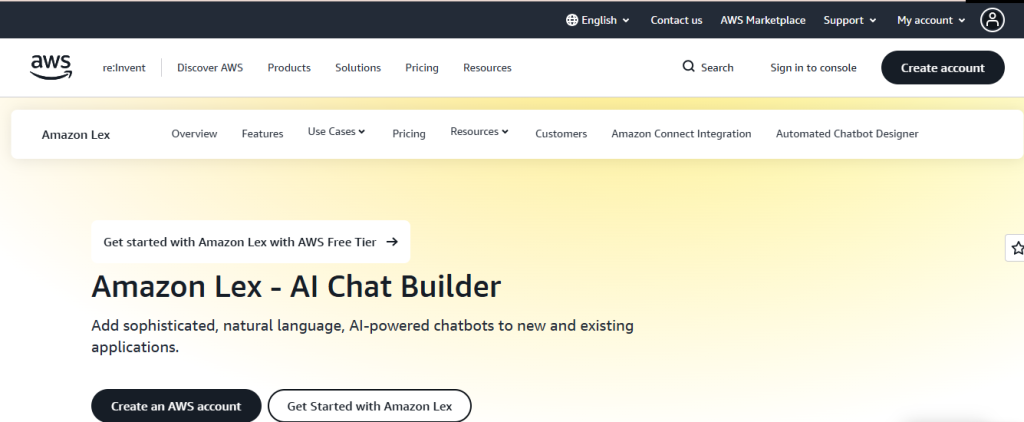
Amazon integrates conversational AI deeply across its ecosystem through Alexa for consumers and Amazon Lex for businesses. Alexa enables natural voice interactions in smart homes and devices, while Lex powers chat and voice bots for customer service and commerce, making conversational AI both a product and a platform at Amazon.
3. Ralph Lauren – Ask Ralph

Ralph Lauren’s Ask Ralph is a conversational AI styling assistant developed with Microsoft Azure OpenAI, allowing users to ask outfit-related questions and receive personalized clothing recommendations. It transforms digital shopping into an interactive, curated experience that blends fashion advice with e-commerce.
4. Lyft – Claude AI for Driver Support

Lyft uses Claude, Anthropic’s conversational AI, to handle driver support inquiries, resolving issues up to 87% faster. By automating and personalizing driver communications, Lyft enhances efficiency and satisfaction for its service providers, demonstrating how conversational AI can optimize internal operations at scale.
5. Delta Air Lines – Delta Concierge

Delta has introduced Delta Concierge, a conversational AI tool within its Fly Delta app that lets passengers speak or type natural-language queries about check-in, baggage, airport navigation, and more. It blends voice/text inputs with real-time contextual guidance to streamline travel.
Conclusion
Conversational AI is changing how companies connect with customers and grow their business. The cost may depend on how complex the system is or how deeply it integrates with other tools, but the real value lies in creating something that keeps learning and improving over time. At Idea Usher, we work with enterprises to build conversational AI systems that actually make sense for their goals and budgets. Our approach helps you design solutions that stay smart, efficient, and ready to scale, so you can focus on growth while your AI handles the rest.
Looking to Develop a Conversational AI?
Don’t settle for another generic chatbot. At Idea Usher, we design and engineer Conversational AI that drives real results, from automating customer support to closing more sales.
Our team brings over 500,000 hours of hands-on development and experience from top MAANG/FAANG companies, combining technical excellence with strategic insight.
We create AI solutions that:
- Reflect your brand’s voice and personality.
- Integrate seamlessly into your existing systems.
- Deliver measurable impact across engagement, efficiency, and revenue.
See how expertise and thoughtful design can transform your conversations.
Explore our work and let’s talk about building something extraordinary.
Work with Ex-MAANG developers to build next-gen apps schedule your consultation now
FAQs
A1: Building a conversational AI from scratch can cost anywhere between twenty thousand and three hundred thousand dollars, depending on what you want it to do and how advanced it should be. The budget will usually depend on the size of your project and how many integrations or models you decide to include. It is always better to start with clear goals so you can manage the costs effectively.
A2: The overall cost is mostly influenced by how complex the natural language understanding system is and how much data needs to be prepared. You might also need to factor in expenses for third-party API connections and the amount of usage for large language models. A project that needs custom AI behavior or deeper integration will almost always cost more.
A3: Most conversational AI projects take about three to six months to build from the ground up. The exact time frame will depend on how big the project is and how many features are required. With good planning and an agile approach, you can often shorten the timeline without cutting corners on quality.
A4: Yes, that is often the best way to begin because it lets you test ideas quickly and learn from real users. Many companies start with a simple pilot bot that handles a few tasks and then expand it over time. A modular setup will allow you to scale easily as your needs grow and your user base increases.
